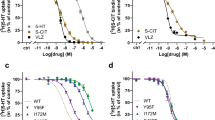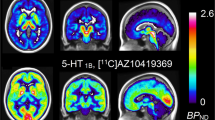Abstract
The discovery of high-affinity binding sites for psychoactive drugs such as benzodiazepines1,2, opiates3 and neuroleptics4 has opened up new approaches to the study of these drugs and their mechanisms of action. Although most tricyclic antidepressants inhibit neuronal uptake of noradrenaline and serotonin5, their mechanism of action remains unclear. Changes in the sensitivity of the β-receptor after chronic tricyclic antidepressant treatment6,7 suggest that they modulate noradrenergic neuro-transmission. Tricyclic antidepressants also act directly on cholinergic8, histaminergic9, α-adrenergic10 and serotonergic11 receptors. It is not clear, however, which, if any, of these effects are related to the primary antidepressant effect or whether they are simply responsible for some of the side effects. We have thus investigated the possibility that specific binding sites for tricyclic antidepressants exist in the central nervous system. So far, binding studies using 3H-labelled tricyclic antidepressant drugs have only detected binding to histaminergic H2 and cholinergic muscarinic receptors12 and low-affinity binding13. We demonstrate here a population of specific high-affinity binding sites for 3H-imipramine on brain membranes which may be responsible for the antidepressant effects of these drugs.
This is a preview of subscription content, access via your institution
Access options
Subscribe to this journal
Receive 51 print issues and online access
$199.00 per year
only $3.90 per issue
Buy this article
- Purchase on Springer Link
- Instant access to full article PDF
Prices may be subject to local taxes which are calculated during checkout
Similar content being viewed by others
References
Braestrup, C. & Squires, R. F. Nature 266, 732–734 (1977).
Mohler, H. & Okada, J. Life Sci. 20, 2101–2110 (1977).
Pert, C. B. & Snyder, S. H. Science 179, 1011–1014 (1973).
Burt, D. R., Creese, I. & Snyder, S. H. Molec. Pharmac. 12, 800–812 (1976).
Glowinski, J. & Axelrod, J. Nature 204, 1318–1319 (1964).
Vetulani, J., Starwarz, R. J., Dingell, J. V. & Sulser, F. Naunyn-Schmiedebergs Archs Pharmak. 293, 109–114 (1976).
Wolfe, B. B., Harden, T. K., Sporn, J. R. & Molinoff, P. B. J. Pharm. exp. Ther. 207, 446–457 (1978).
Snyder, S. H. & Yamamura, H. I. Archs gen. Psychiat. 34, 236–239 (1977).
Green, J. P. & Maayani, S. Nature 269, 163–165 (1977).
U'Prichard, D. C., Greenberg, D. A., Sheenan, P. P. & Snyder, S. H. Science 199, 197–198 (1978).
Bennett, J. L. & Aghajanian, G. K. Life Sci. 15, 1935–1944 (1975).
Rehavi, M. & Sokolovsky, M. Brain Res. 149, 525–529 (1978).
O'Brien, R. A., Spirt, N. W. & Horst, W. D. Neurosci. Abstr. 4, 1366 (1978).
Chen, G. & Bohner, B. J. Pharm. exp. Ther. 131, 179–184 (1961).
Gouret, C. & Thomas, J. J. Pharma., Paris 4, 401–404 (1973).
Raisman, R., Briley, M. S. & Langer, S. Z. Eur. J. Pharmac. 54, 307–308 (1979).
Randrup, A. & Braestrup, C. Psychopharmacology 53, 309–314 (1977).
Author information
Authors and Affiliations
Rights and permissions
About this article
Cite this article
Raisman, R., Briley, M. & Langer, S. Specific tricyclic antidepressant binding sites in rat brain. Nature 281, 148–150 (1979). https://doi.org/10.1038/281148a0
Received:
Accepted:
Issue Date:
DOI: https://doi.org/10.1038/281148a0
This article is cited by
-
Linking emotion to the social brain
EMBO reports (2007)
-
Influence of various combinations of specific antibody dose and affinity on tissue imipramine redistribution
British Journal of Pharmacology (1998)
-
[3H]Paroxetine and [3H]citalopram as markers of the human brain 5-HT uptake site: a comparison study
Journal of Neural Transmission (1994)
-
Binding of some antidepressants to the 5-hydroxytryptamine transporter in brain and platelets
Psychopharmacology (1990)
Comments
By submitting a comment you agree to abide by our Terms and Community Guidelines. If you find something abusive or that does not comply with our terms or guidelines please flag it as inappropriate.



